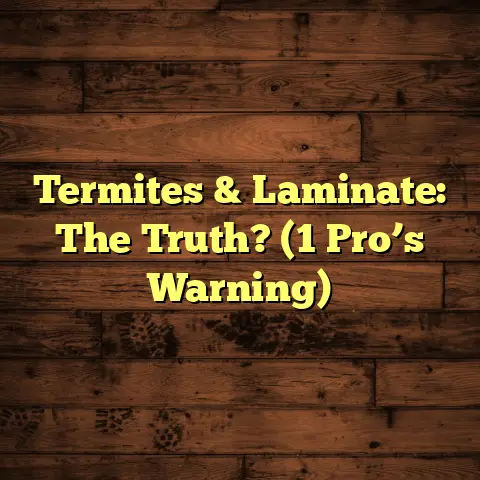Attic Flooring: What Works Best? (1 Bad Choice!)
Flooring, to me, isn’t just about covering the subfloor. It’s an art form.
It’s the canvas upon which you paint your life, a foundation that can completely transform a space.
Think about it: The right flooring can take a drab, dusty attic and turn it into a cozy reading nook, a vibrant home office, or even a kid’s dream playroom.
The possibilities are endless, and the choices you make can dramatically impact the aesthetic and functionality of your home.
I’ve seen firsthand how the perfect flooring can breathe new life into an attic.
But I’ve also witnessed the disaster that can unfold when the wrong material is chosen.
So, let’s dive deep into the world of attic flooring.
I’ll guide you through the best options, the crucial factors to consider, and, most importantly, the one choice you should absolutely avoid.
Trust me, your attic will thank you!
1. Understanding Attic Spaces and Their Uses
First things first, let’s talk about attics.
These spaces are often the unsung heroes of our homes, but they come with their own unique set of challenges.
Typically, attics are characterized by:
- Unique Dimensions: Sloped ceilings and awkward angles are the norm.
- Temperature Swings: They can be blazing hot in the summer and freezing cold in the winter.
- Limited Access: Getting materials up there can be a real pain.
Now, what do people do with their attics? I’ve seen it all:
- Storage Central: The classic use – storing holiday decorations, old furniture, and forgotten treasures.
- Extra Living Space: A guest bedroom, a teen hangout, or a cozy retreat.
- Home Office Haven: A quiet space to focus and get work done.
- Kid’s Play Zone: A dedicated area for imagination and fun.
The intended use of your attic is the most important factor driving your flooring decision.
A storage space might only need basic, durable flooring, while a living space will need something more comfortable and aesthetically pleasing.
2. Popular Flooring Options for Attics
Alright, let’s get into the good stuff!
Here are some of the most popular flooring options for attics, along with my insights from years of experience:
2.1 Hardwood Flooring
Ah, hardwood. It’s a classic for a reason.
The rich, natural beauty of hardwood can instantly elevate any space, and it adds serious value to your home.
Plus, it’s durable and can last for decades with proper care.
Think about this: A study by the National Wood Flooring Association (NWFA) found that homes with hardwood floors often sell for higher prices than those with other types of flooring.
- Aesthetic Appeal: Hardwood brings warmth and sophistication.
- Durability: It can withstand heavy foot traffic and everyday wear and tear.
- Home Value: It’s a desirable feature for potential buyers.
But, not all hardwoods are created equal, especially for attic environments.
I’d suggest considering these types:
-
Engineered Hardwood: This is a great option because it’s more resistant to moisture and temperature fluctuations than solid hardwood. It’s made with layers of plywood underneath a hardwood veneer, which gives it stability.
-
Bamboo: Technically a grass, bamboo is incredibly strong and sustainable. It’s also relatively moisture-resistant, making it a good choice for attics.
My Pro Tip: If you go with hardwood, make sure to install a vapor barrier underneath to protect it from moisture coming from below.
2.2 Laminate Flooring
Laminate is the budget-friendly champion of the flooring world.
It’s a synthetic material that mimics the look of hardwood, tile, or stone, but at a fraction of the cost.
It’s also super easy to install, which can save you even more money on labor.
- Cost-Effectiveness: Laminate is significantly cheaper than hardwood.
- Easy Installation: Many laminate floors are designed with a click-lock system, making them DIY-friendly.
- Variety of Styles: You can find laminate that looks like just about anything you want.
I’ve used laminate in countless attic renovations, and it’s always a hit with clients who are looking for a stylish and affordable option.
Just keep in mind that laminate isn’t as durable as hardwood, and it’s not waterproof.
So, if your attic is prone to leaks or high humidity, you might want to consider a different option.
My Pro Tip: Look for laminate flooring with a high AC (Abrasion Class) rating. This indicates how well it can withstand wear and tear.
2.3 Carpet
Carpet is all about comfort and warmth.
If you’re turning your attic into a cozy retreat, a bedroom, or a playroom, carpet can be a fantastic choice.
It’s soft underfoot, it absorbs sound, and it can make a space feel instantly more inviting.
- Warmth and Comfort: Carpet provides a soft and cozy surface.
- Sound Absorption: It helps to reduce noise, which is great for shared walls.
- Insulation: Carpet can add an extra layer of insulation to your attic.
However, carpet also has its drawbacks.
It can be a magnet for dust, dirt, and allergens, and it’s not the most moisture-resistant option.
I’ve seen too many cases of mold and mildew growing under carpets in damp attics.
My Pro Tip: If you choose carpet, opt for a low-pile variety and consider using a moisture-resistant underlayment. Regular vacuuming is also essential to keep it clean and fresh.
2.4 Vinyl Flooring
Vinyl flooring has come a long way in recent years.
It’s no longer the cheap, flimsy stuff you might remember from your grandma’s kitchen.
Today’s vinyl flooring is durable, water-resistant, and available in a wide range of styles and designs.
- Resilience: Vinyl is tough and can withstand heavy traffic.
- Water Resistance: It’s a great option for attics that might experience moisture issues.
- Variety of Designs: You can find vinyl that looks like wood, tile, stone, and more.
I often recommend vinyl flooring for attics because it’s a practical and versatile choice.
It’s easy to clean, it’s comfortable underfoot, and it can handle temperature fluctuations without warping or cracking.
My Pro Tip: Look for luxury vinyl plank (LVP) or luxury vinyl tile (LVT). These are thicker and more durable than traditional sheet vinyl.
2.5 Tile Flooring
Tile is the king of durability.
If you’re looking for a flooring option that can withstand just about anything, tile is it.
It’s waterproof, stain-resistant, and incredibly long-lasting.
- Durability: Tile can last for decades with proper care.
- Water Resistance: It’s ideal for attics that might be exposed to moisture.
- Easy Cleaning: Tile is a breeze to clean and maintain.
However, tile can also be cold and hard underfoot, which might not be ideal for a cozy attic space.
It’s also a more challenging material to install than some of the other options on this list.
My Pro Tip: If you choose tile, consider installing radiant floor heating to add warmth and comfort.
Also, make sure your attic floor is strong enough to support the weight of the tile.
3. Factors to Consider When Choosing Attic Flooring
Okay, now that we’ve covered the different flooring options, let’s talk about the factors you need to consider before making your final decision.
3.1 Insulation and Temperature Control
Attics are notorious for being poorly insulated.
This means they can get extremely hot in the summer and freezing cold in the winter.
Your flooring choice can impact the insulation of your attic and your overall energy bills.
- Carpet: Provides the best insulation and helps to retain heat.
- Vinyl and Laminate: Offer moderate insulation.
- Tile: Can be cold and may require additional insulation.
- Hardwood: Provides minimal insulation.
My Pro Tip: Consider adding extra insulation to your attic walls and ceiling to improve energy efficiency and make your space more comfortable year-round.
3.2 Weight and Structural Integrity
Attic floors are not always designed to support heavy loads.
Before you install any new flooring, it’s crucial to assess the load-bearing capacity of your attic floor.
- Heavy Materials: Tile and solid hardwood are the heaviest flooring options.
- Lighter Materials: Laminate, vinyl, and carpet are lighter and less likely to strain the structure.
My Pro Tip: If you’re unsure about the load-bearing capacity of your attic floor, consult with a structural engineer or a qualified contractor.
3.3 Moisture and Humidity
Attics can be prone to moisture problems, especially if they’re not properly ventilated.
Moisture can lead to mold, mildew, and structural damage.
- Moisture-Resistant Options: Vinyl and tile are the most moisture-resistant flooring choices.
- Moisture-Sensitive Options: Carpet and solid hardwood are more susceptible to moisture damage.
My Pro Tip: Install a vapor barrier underneath your flooring to protect it from moisture coming from below.
Also, make sure your attic is properly ventilated to prevent moisture buildup.
3.4 Aesthetic Harmony
Finally, don’t forget about aesthetics!
Your attic flooring should complement the overall design of your home and reflect your personal style.
- Consider the Existing Decor: Choose a flooring style that coordinates with the rest of your home.
- Think About the Mood: Do you want your attic to feel cozy and inviting, or sleek and modern?
My Pro Tip: Gather inspiration from magazines, websites, and home improvement shows to get ideas for your attic flooring.
4. The One Bad Choice: Understanding the Risks of Certain Flooring Types
Alright, it’s time for the big reveal!
After years of experience, I can confidently say that there’s one flooring material that I generally advise against for attics:
Solid Hardwood Directly Over an Uninsulated Subfloor.
Here’s why:
-
Moisture Problems: Solid hardwood is highly susceptible to moisture damage. In an attic, where temperature and humidity can fluctuate wildly, this can lead to warping, cupping, and even rot.
-
Lack of Insulation: Hardwood offers very little insulation. This means your attic will be colder in the winter and hotter in the summer, leading to higher energy bills.
-
Installation Challenges: Installing solid hardwood can be tricky, especially in an attic with sloped ceilings and awkward angles.
I remember one project where a homeowner insisted on installing solid hardwood in their attic, despite my warnings.
Within a year, the floors started to warp and buckle due to moisture.
They ended up having to replace the entire floor, which cost them a fortune.
My Pro Tip: If you’re set on having hardwood floors in your attic, opt for engineered hardwood instead.
It’s more stable and resistant to moisture than solid hardwood.
Conclusion: Making the Right Choice for Your Attic
Choosing the right flooring for your attic can be a daunting task, but it’s definitely worth the effort.
By considering the factors I’ve discussed in this article, you can make an informed decision that will enhance both the functionality and beauty of your space.
Remember to think about:
- The intended use of your attic
- Your budget
- The climate in your area
- Your personal style
And, most importantly, avoid the one bad choice: solid hardwood directly over an uninsulated subfloor.
With the right flooring, your attic can become a true work of art within your home.
So, go ahead and transform that dusty, unused space into something amazing!





